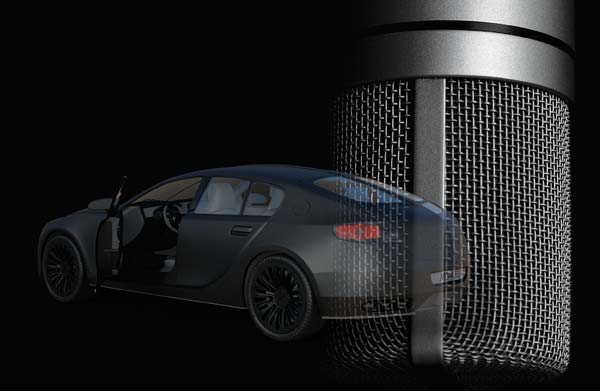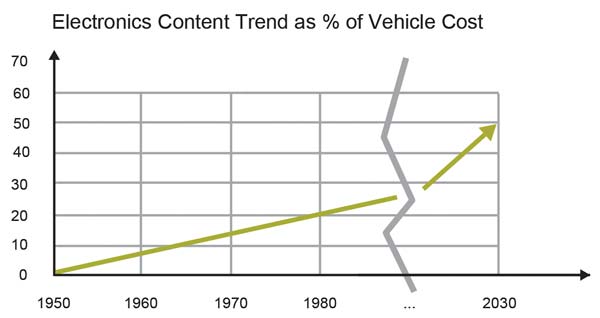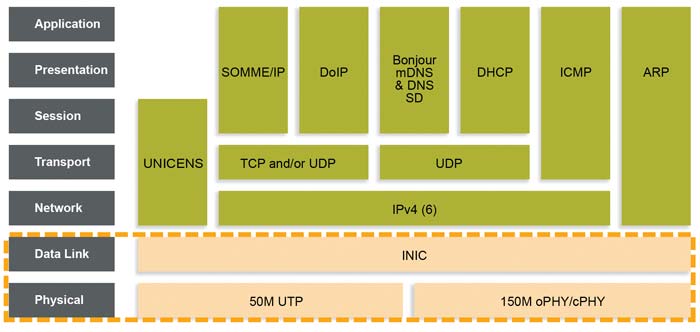 This approach solves many of the automotive networking challenges; however, it generates other challenges in certain infotainment, audio, or acoustic use-cases, just to mention some. In particular the transmission of audio signals is the big challenge and needs additional expensive hardware and software components. All these measures are complex and costly and impacts the risk, cost and time to market of the design to the negative.
This approach solves many of the automotive networking challenges; however, it generates other challenges in certain infotainment, audio, or acoustic use-cases, just to mention some. In particular the transmission of audio signals is the big challenge and needs additional expensive hardware and software components. All these measures are complex and costly and impacts the risk, cost and time to market of the design to the negative.
The new INICnet technology though offers all needed audio features such as the transfer of multiple dedicated audio and video channel in parallel with high quality of service and low latency without the need of additional hardware or software. On top of that it provides also an Ethernet/IP channel enabling use-cases such as SW download (incl. Over The Air – OTA) and diagnostics plus a seamless link to the remainder of the vehicle network which is for sure Automotive Ethernet.
But why do we need another open standard in the already crowded automotive standards landscape?
This answer can be found by having a glance on the major challenges facing the overall automotive industry. It is struggling to become more innovative as it begins to imitate the fast-moving consumer product lifecycles while at the same time trying to save costs. Vehicle electronics are at the heart of this. There has been a rapid rise in the amount of electronics in a typical vehicle, as can be seen in Figure 1. This growth will continue due to the three megatrends of vehicle electrification, more sophisticated driver assistance on the road to autonomous driving, and increased connectivity both within the vehicle and with other vehicles and the infrastructure.
This has led to vast amounts of data being exchanged between different components inside a vehicle and between the vehicle and the infrastructure, and the numbers are only going to increase.
This places a new burden on the in-vehicle networks, which have traditionally been domain-based networks such as CAN, Flexray, LIN and MOST, covering dedicated tasks for different types of data depending on the bandwidth and real-time requirements of the communications.
As such, it is becoming more common for domain-based architectures to be replaced by a backbone approach in which an unshielded twisted pair (UTP) based high-speed Ethernet backbone covers the networking requirements. This has the obvious advantage that Ethernet is a mature technology with which a large number of engineers are comfortable and is available with a low-cost physical layer. UTP can help reduce development costs, project risk and time to market for new cars. However, not all data exchanged in in-vehicle networks are natively available as packet data.
Consider for example audio data in an infotainment system or in an acoustic application such as active noise cancellation (ANC), or in passenger-to-passenger communications.
The implementation of this kind of application with an Ethernet network would imply the use of special standards such as Audio Video Bridging (AVB) that fulfils all requirements of audio applications such as synchronisation, low latency and reliability, but are very complex to implement in software and require high performing computing power just for handling the networking. The implementation cost of a complex software stack on a high performing microcontroller eat up all s the benefits of a network standard.
How to avoid that and deploy a network standard for audio, acoustics and infotainment without high implementation costs?
The answer to this questions INICnet technology. INICnet technology will become an open ISO standard in 2021 and supports high quality of service audio and video channels that are completely managed through the INICnet ICs or through the available lean software, so that the engineers do not need extra development effort for handling the traffic on the network. INICnet technology provides UTP or coaxial cable as physical layers, is fully compatible with Ethernet, as each node has its own MAC address and it supports all Ethernet related mechanisms, addressing modes and packet sizes.
INICnet technology is available in two different speed grades with a high bandwidth efficiency of more than 95%: 50Mbit/s or 150MB/s. Both options support ring or daisy chain. 50 Mb/s are available over UTP, 150Mbit/s are available over coaxial cable.
INICnet technology supports phantom power and provides a comprehensive diagnosis without the need for extra triggering cables. Figure 2 shows a typical example of how INICnet technology and an Ethernet network can coexist. The advantage of this network architecture is that the audio video applications can be based on INICnet technology as it handles audio or video data in native format; developers can concentrate on their applications without caring about complex data transforming or network tasks. Another advantage is that a fast firmware update in each INICnet device could also take place over the air, as INICnet technology supports native Ethernet packets as well and is connected to the rest of the vehicle backbone over one of its devices, such as, for example, the head unit. There is no need to have a gateway application in the head unit as each INICnet device can be directly addressed by its own unique MAC address.
Considering the ISO/OSI model for the , INICnet technology’s Ethernet Channel, it covers the first two layers of the model only, as can be seen in Figure 3; therefore, it can be completely abstracted from the higher layers, so that software that has been written for other technologies can be reused after a driver update. Currently there are drivers for Linux and QNX available that can be used together with the INICnet ICs and allows the INICnet technology’s Ethernet channel to be integrated into already existing IP-based system in a completely transparent way, so that the development engineers do not need to care about the underlying networking technology.
Microchip offers a complete family of application-specific products targeting low-latency applications such as ANC, motor sound generation, road noise cancellation, e-call or other application that requires low latency, as shown in Figure 4. Each INIC IC can be configured as a network master or network slave and can change its mode automatically if, say, after a car accident, the network is damaged, and the car user wants to perform an e-call.
The network resource management and the network configuration of INICnet technology can be done by Microchip’s UNICENS unified centralised network stack. All other system management functions such as device control for example might be supported by available IP stacks such as SOME/IP stack, or any other Remote Procedure Call (RPC) techniques. UNICENS is an open source application, is available for free and lets users configure the whole network from a single device; this make it is possible to implement devices that do not need a microcontroller like microphone nodes. In case that there are nodes in the network that are only dealing with ethernet traffic like e.g. a smart antenna, this kind of nodes do not need to contain any kind of network software, or best case, if the generated data is native ethernet, it is possible to design the node without using a microcontroller in it.
The market understands the advantages of the INICnet technology, as evidenced by the first automotive OEM adoption of this technology which began in mid of 2018 and will go into production in 2020. OEMS and Tier1s in different regions across the globe have also already started the evaluation of the technology and are working together with the Microchip experts to make another success story of it.
Author: Carmelo De Mola,
Manager Sales & Marketing at Microchip Technology Inc; K2L GmbH & C0. KG.
For more information about the INICnet technology, please contact your local Microchip representative or send an e-Mail to INICnet@microchip.com
Microchip Technology | https://www.microchip.com







